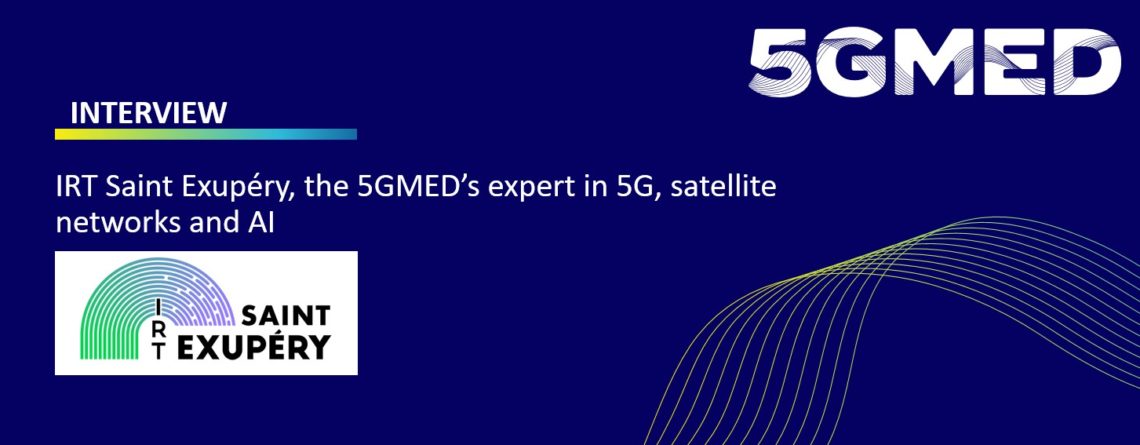IRT Saint Exupéry, the 5GMED’s expert in 5G, satellite networks and AI
IRT Saint Exupéry is a technological research institute that accelerates science, technology research and transfer to aeronautics, space and embedded systems industries through the development of dependable, robust, certifiable and sustainable innovative solutions.
At our sites in Toulouse, Bordeaux, Sophia Antipolis and Montreal, we offer an integrated collaborative environment composed of 350 engineers, researchers, experts and PhD students from academia and industry for research projects and R&T services supported by technological platforms around 4 axes: advanced manufacturing technologies, greener technologies, smart technologies and methods & tools for the development of complex systems.
*We are a private research foundation, supported by the French government, which funds projects in proportion to the industrial contribution and defines the regulatory framework of the foundation.”
Describe your role in 5GMED
In this frame, our expertise in 5G and satellite networks (which belongs to the smart technologies axe) will be used to develop a satellite slice backhauling a gNB located in the train (mobile platform backhauling). Our expertise in AI will be used to create several AI modules to support several use cases (automotive and train). Finally, IRT will use its DEVOPS team to develop a network data collection tool based on the NWDAF model specified by 3GPP. Besides, IRT was in charge of leading the initial definition of 5GMED use cases, services and test cases as IRT is the leader for this work package. IRT will use its expertise in order to:
- Collaborate with the NPM3D laboratory of Paris’ Ecole des Mines for developing and implementing the obstacle detection AI module for the train;
- Develop the AI module for optimization of the orchestrator in order to participate in an optimal placement of the virtual functions at the EDGE. It will contribute to the EMT (Enjoy Media Together) and TP (Tour Planning) services performances optimisation along the corridor;
- Develop the AI module for QoS prediction in the frame of the teleoperated driving service on the highway. This service is critical in terms of security and very much dependent upon the network performance. The AI module will help anticipate the network performance degradation and therefore help take in advance countermeasures in order to keep the operation secure.
- Develop a mini NWDAF (Network Data Analytics Function) in order to collect and distribute the relevant 5GMED network metrics.
- Develop a satellite slice in the train which will, in particular, carry the backhauling for the neutral host cell located in the train.
Define the importance of 5G technologies
The 5G System architecture is such that the mobile networks can be deployed using techniques such as Network Function Virtualization and Software Defined Networking, resulting in an unmatched deployment flexibility. The 5G architecture Minimizes dependencies between the Access Network (AN) and the Core Network (CN), allowing much more flexibility on the ANs than with previous generation systems. Finally, in the 5G SA Architecture a modular function design enables flexible and efficient network slicing. 5GMED will experiment with services with such tight constraints on the Mobile Networks in terms of uplink and downlink throughput and/or in terms of latency that only 5G SA technology can fulfil the requirements. In IRT, our activities with 5G relate to integrating the space segment seamlessly with the 5G networks.
Explain the impact of the project in short term and long term
Short term impact is to prove that a 5G SA network, release 16 and 17, brings the network performances at the level required by cutting edge automotive and train use cases, especially at cross borders where the legacy mobile networks could not match those performances. A longer-term impact will come from the upscaling of the architecture proved in 5GMED:
– By using the experimented roaming solutions allowed by 5GS SA and the inter-RAT (Radio Access Technologies) handover solutions, both rendering possible seamless services.
– By using the MEC solutions tested in 5GMED for automotive and train verticals for low latency and high data rate simultaneously.
– By using AI for approaching network performance prediction, etc.
Do not miss our next interview, follow us on our social media for more: Linkedin – Twitter.


